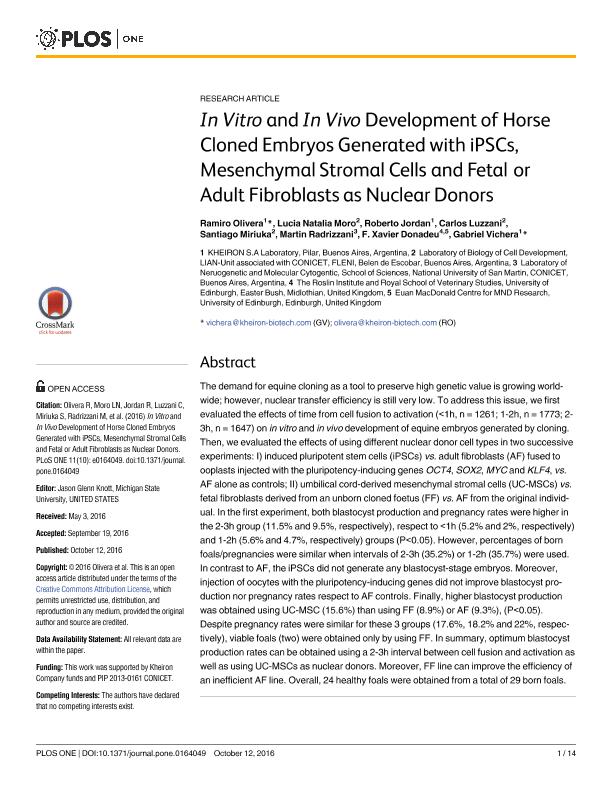Mostrar el registro sencillo del ítem
dc.contributor.author
Olivera, Ramiro
dc.contributor.author
Moro, Lucía Natalia

dc.contributor.author
Jordan, Roberto
dc.contributor.author
Luzzani, Carlos Daniel

dc.contributor.author
Miriuka, Santiago Gabriel

dc.contributor.author
Radrizzani Helguera, Martin

dc.contributor.author
Xavier Donadeu, F.
dc.contributor.author
Vichera, Gabriel Damian

dc.date.available
2018-03-12T21:35:12Z
dc.date.issued
2016-10
dc.identifier.citation
Olivera, Ramiro; Moro, Lucía Natalia; Jordan, Roberto; Luzzani, Carlos Daniel; Miriuka, Santiago Gabriel; et al.; In Vitro and in vivo development of horse cloned embryos generated with iPSCs, mesenchymal stromal cells and fetal or adult fibroblasts as nuclear donors; Public Library of Science; Plos One; 11; 10; 10-2016; 1-14
dc.identifier.issn
1932-6203
dc.identifier.uri
http://hdl.handle.net/11336/38637
dc.description.abstract
The demand for equine cloning as a tool to preserve high genetic value is growing worldwide; however, nuclear transfer efficiency is still very low. To address this issue, we first evaluated the effects of time from cell fusion to activation (<1h, n = 1261; 1-2h, n = 1773; 2-3h, n = 1647) on in vitro and in vivo development of equine embryos generated by cloning. Then, we evaluated the effects of using different nuclear donor cell types in two successive experiments: I) induced pluripotent stem cells (iPSCs) vs. adult fibroblasts (AF) fused to ooplasts injected with the pluripotency-inducing genes OCT4, SOX2, MYC and KLF4, vs. AF alone as controls; II) umbilical cord-derived mesenchymal stromal cells (UC-MSCs) vs. fetal fibroblasts derived from an unborn cloned foetus (FF) vs. AF from the original individual. In the first experiment, both blastocyst production and pregnancy rates were higher in the 2-3h group (11.5% and 9.5%, respectively), respect to <1h (5.2% and 2%, respectively) and 1-2h (5.6% and 4.7%, respectively) groups (P<0.05). However, percentages of born foals/pregnancies were similar when intervals of 2-3h (35.2%) or 1-2h (35.7%) were used. In contrast to AF, the iPSCs did not generate any blastocyst-stage embryos. Moreover, injection of oocytes with the pluripotency-inducing genes did not improve blastocyst production nor pregnancy rates respect to AF controls. Finally, higher blastocyst production was obtained using UC-MSC (15.6%) than using FF (8.9%) or AF (9.3%), (P<0.05). Despite pregnancy rates were similar for these 3 groups (17.6%, 18.2% and 22%, respectively), viable foals (two) were obtained only by using FF. In summary, optimum blastocyst production rates can be obtained using a 2-3h interval between cell fusion and activation as well as using UC-MSCs as nuclear donors. Moreover, FF line can improve the efficiency of an inefficient AF line. Overall, 24 healthy foals were obtained from a total of 29 born foals.
dc.format
application/pdf
dc.language.iso
eng
dc.publisher
Public Library of Science

dc.rights
info:eu-repo/semantics/openAccess
dc.rights.uri
https://creativecommons.org/licenses/by-nc-sa/2.5/ar/
dc.subject
Cloning
dc.subject
Mesenchymal Stem Cells
dc.subject
Ipsc
dc.subject.classification
Otras Biotecnología Agropecuaria

dc.subject.classification
Biotecnología Agropecuaria

dc.subject.classification
CIENCIAS AGRÍCOLAS

dc.title
In Vitro and in vivo development of horse cloned embryos generated with iPSCs, mesenchymal stromal cells and fetal or adult fibroblasts as nuclear donors
dc.type
info:eu-repo/semantics/article
dc.type
info:ar-repo/semantics/artículo
dc.type
info:eu-repo/semantics/publishedVersion
dc.date.updated
2018-03-12T18:32:41Z
dc.journal.volume
11
dc.journal.number
10
dc.journal.pagination
1-14
dc.journal.pais
Estados Unidos

dc.journal.ciudad
San Francisco
dc.description.fil
Fil: Olivera, Ramiro. Kheiron S.a Laboratory; Argentina
dc.description.fil
Fil: Moro, Lucía Natalia. Consejo Nacional de Investigaciones Científicas y Técnicas; Argentina. Fundación para la Lucha contra las Enfermedades Neurológicas de la Infancia; Argentina
dc.description.fil
Fil: Jordan, Roberto. Kheiron S.a Laboratory; Argentina
dc.description.fil
Fil: Luzzani, Carlos Daniel. Consejo Nacional de Investigaciones Científicas y Técnicas; Argentina. Fundación para la Lucha contra las Enfermedades Neurológicas de la Infancia; Argentina
dc.description.fil
Fil: Miriuka, Santiago Gabriel. Fundación para la Lucha contra las Enfermedades Neurológicas de la Infancia; Argentina. Consejo Nacional de Investigaciones Científicas y Técnicas; Argentina
dc.description.fil
Fil: Radrizzani Helguera, Martin. Consejo Nacional de Investigaciones Científicas y Técnicas; Argentina. Universidad Nacional de San Martín; Argentina
dc.description.fil
Fil: Xavier Donadeu, F.. University of Edinburgh; Reino Unido. Consejo Nacional de Investigaciones Científicas y Técnicas; Argentina
dc.description.fil
Fil: Vichera, Gabriel Damian. Kheiron S.a Laboratory; Argentina
dc.journal.title
Plos One

dc.relation.alternativeid
info:eu-repo/semantics/altIdentifier/url/http://journals.plos.org/plosone/article?id=10.1371/journal.pone.0164049
dc.relation.alternativeid
info:eu-repo/semantics/altIdentifier/doi/http://dx.doi.org/10.1371/journal.pone.0164049
Archivos asociados
